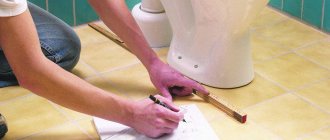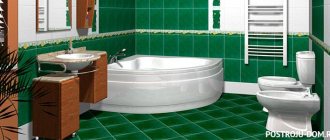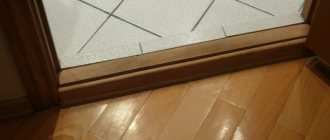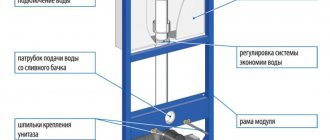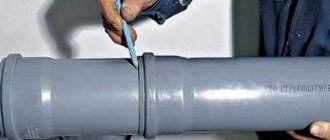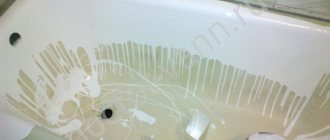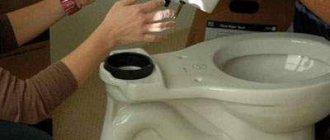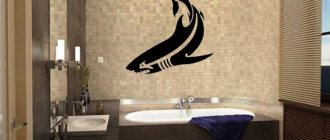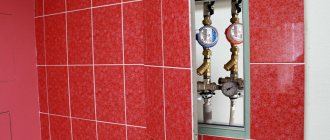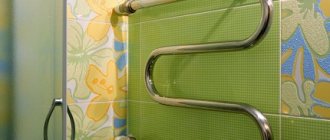Toilets with an oblique outlet have been market leaders for several years. Their popularity can be explained simply: it is this connection to the sewer system that is most convenient, because... elements do not need to be adjusted during installation.
These models are perfect for both apartments in high-rise buildings and private houses. And, if desired, you can handle the installation yourself. In our article we will look at how to install a toilet with an oblique outlet without outside help. We will provide step-by-step instructions, describing each step in detail. All actions are accompanied by visual photos and recommendations from specialists.
Toilet features
A toilet with an oblique outlet is considered universal, since it can be connected to any socket coming from the sewer system. If we take a plumbing item with a direct outlet as an example, then the pipe for it must be located on the floor. When the socket is installed at an angle, it is quite difficult to install a toilet with a direct outlet. This will require modifications to move the sewer pipe forward. However, the finished result looks unaesthetic, and it is unacceptable to take up extra centimeters in a small room.
A toilet with an oblique outlet is in greatest demand for several reasons:
- Most modern houses are designed to install just this type of plumbing;
- The oblique outlet increases water resistance, which reduces the frequency of blockages.
- Cleaning the pipe is quite easy using chemicals. Due to the convenient location of the pipe, decomposed garbage will easily pass into the sewer.
- Installing a toilet with an oblique outlet is much easier than its closest brother. Even if there are slight deviations with the bell, it is not difficult to correct.
Features of installing a toilet with an oblique outlet
Universal
A feature of the functional universal design of the toilet outlet is the removal of sewage and domestic water using various elements that provide a transition to the wall or floor. On toilets with a universal outlet type, the outlet pipe is located in a horizontal position at the rear of the structure. The price for such models is usually noticeably higher.
Model advantages:
- operational comfort;
- absence of unpleasant sewer odors;
- maximum convenience of independent repair work;
- Possibility of use with different sewerage options.
Main disadvantages of the configuration:
- the need to use adapters for installation in the floor or riser;
- high cost of imported sanitary products;
- some maintenance problems.
Due to their design features, plumbing fixtures with a universal outlet option are successfully used in sewer systems of various types. Thanks to correctly selected adapters and the ability to make an easy, quickest independent connection, universal releases are in high demand.
Main types of toilet release
Types of toilets with oblique outlet
Before purchasing and installing a toilet, you should decide on its type. Based on the type of design, plumbing fixtures are divided into the following subtypes:
- Separated. This type is characterized by a separately installed tank. It can be mounted on a wall or even a ceiling, and is connected to the structure by a drain pipe. This toilet is not in demand because it does not efficiently use the space in the bathroom. So, you can build a small cabinet or shelves on the wall, but you have to install a tank.
- Compact. This type is the most popular due to saving space in the bathroom. The tank and bowl are connected into a single structure, which allows it not to take up extra space. Installing such a toilet is quite easy.
- Monoblock. This is a modern and quite expensive type of toilet, in which the tank and waste bowl form a single unit. It is compact, does not take up much space and looks very attractive.
- Angular. A corner toilet is installed in the corner of the room, which allows rational use of space. Not suitable for all apartments.
Features of a corner toilet with an oblique outlet
The remaining selection criteria are inherent for all types of toilets, regardless of the location of the socket. So, you will have to choose between earthenware, porcelain type with cascade or circular flush, with bottom or side water supply.
Features of choosing plumbing equipment
Progress does not stand still, and manufacturers are constantly offering consumers new types of plumbing fixtures. In order to make a responsible choice and purchase a high-quality model, you need to take into account several criteria at once.
Latrine model
This criterion depends on the area of the toilet room and your preferences. If the bathroom is small, then you can purchase a hanging option. In this case, the entire floor surface will be freed up, and the room will be easy to keep clean.
Important! In addition to hanging options, the market offers floor-standing and wall-mounted models.
Bowl shape
The following bowl shapes are distinguished: round, funnel-shaped, with a shelf (plate-shaped), with a slope. In the model with a funnel-shaped bowl, the drain hole is located in the center. In a design with a slope, the drain hole is shifted to one side.
Important! The option with a shelf is currently used quite rarely, due to numerous disadvantages.
Drain system
The market offers models with continuous drainage of water (single-mode) and models in which drainage occurs in a certain dosage (dual-mode). The latest model allows you to regulate and control water flow as needed.
Type of tank
Based on this feature, the following types of latrines can be distinguished:
- compacts (with detachable tank and cast product);
- toilets with a flush cistern of a hidden installation type;
- hanging tanks.
Models with hanging tanks are used less and less due to their unpopularity. Plumbing fixtures with a concealed-mounted cistern are becoming increasingly popular due to their advantages: compactness (the cistern is mounted in a wall or niche), stronger drainage, and quietness.
Material of manufacture
One of the distinctive features of the equipment is the material of manufacture. Models made from earthenware, porcelain, acrylic, and metal are available for sale:
- Earthenware absorbs moisture quite strongly, which leads to the appearance of small cracks on the surface and a change in the original color.
- Porcelain practically does not retain dirt, however, the cost of porcelain models is much higher. In addition, porcelain does not withstand shock and mechanical damage.
- Acrylic products can be cared for using cleaning products without abrasive particles.
Important! You can also opt for more fashionable and exotic models made of glass and stone.
Anti-splash system
This system is designed to eliminate splashes from the toilet. The operating principle of this system lies in the special geometry of the drain hole. Often the drain is shifted to one side so that the water column is minimal and splashes are eliminated.
Toilet lid
Models with built-in microlift have appeared on the modern market. This model of lid will not wake up household members with its rattling lowering onto the latrine.
Manufacturer
Pay attention to the models of traditional market “players” - European and American manufacturers. Their products are distinguished by high quality, durability, and reliability. All these characteristics are confirmed by a long-term guarantee.
Toilet installation
Installing a toilet with an oblique outlet during the process of renovating an apartment with your own hands will require a little patience and effort from you. It is necessary to follow several rules and recommendations, which will allow installation to be done quickly and competently. You can't make mistakes! If installed incorrectly, the operation of the plumbing will be disrupted, which will bring additional difficulties. For example, the most common mistake is the formation of gaps between the sewer socket and the drain pipe. All work is carried out in several stages, the first of which is the preparation of tools.
Installation diagram of a toilet with an oblique outlet
Release to the floor
The vertical location of the outlet part allows the toilet to be installed even in conditions of insufficient free space, in small plumbing rooms. The most important difference in the configuration is the presence of a siphon and pipe already built into the product itself. Installation of these models can be done in a variety of ways, which is explained by the lack of connection to the wall.
Model advantages:
- optimal design for a private home;
- Possibility of installation almost anywhere;
- masking the sewer line under the floor;
- maximum convenience of inspection and repair of the output part.
Main disadvantages of the configuration:
- inappropriate layout of the sewer system;
- high cost of professional repair and installation services;
- The cost of the plumbing itself is quite high.
The undeniable advantages of the model range with floor outlet include the ease of choosing a place for installation, installation compactness, the availability of sufficient free space for the installation of additional plumbing fixtures and furniture, high efficiency of the flushing system, the absence of water splashes during the draining process, as well as guaranteed strength and reliability designs.
Preparing to install a toilet
In most cases, a toilet is installed due to the replacement of old plumbing. Therefore, it is necessary to prepare the place, or rather, dismantle the bowl and tank. There are two options here:
- If the toilet was installed using conventional fasteners, simply remove them.
- If the toilet is filled with cement, you will have to work with a chisel and hammer. When dismantling, calculate the impact force. If you hit the earthenware too hard, it will simply crack, and the remaining drain liquid will flood the room.
After removing the fasteners or removing the cement, tilt the toilet bowl back. This will allow the remaining liquid to drain down the drain. Next, remove the corrugation or dismantle the pipes, depending on the method of attaching the plumbing.
We dismantle the old toilet
Often the toilet is installed on a wooden base. It must be completely removed. This is not difficult to do - most likely, it is destroyed mostly due to high humidity. Similar work is carried out with a metal substrate (a grinder is useful here).
Dismantling the old toilet is considered complete after there are no parts, plumbing parts or construction debris left on the floor. Next you will need to fill the base with cement and level it. You will install the new toilet on a flat, clean surface. This will extend the life of the plumbing fixtures and make the installation process easier. There is no need to lay the board down. A cement base into which the fasteners can easily fit will be sufficient.
Toilet mounting
Wait until the cement is completely dry and make holes for the fasteners. You will later insert dowels into them that will hold the plumbing fixtures. Do not make the holes too wide, as this will prevent the toilet from being installed correctly and will allow moisture to penetrate into the substrate.
Additionally, it is worth replacing the metal pipe through which water is supplied to the toilet. Install a flexible hose that will last much longer and will not leak water.
Rules for installing a toilet
As mentioned earlier, flush toilets are universal and suitable for all types of pipes. Installing plumbing is not difficult using a drain pipe or a plastic socket, but only if the sewer socket is on the same axis as the bowl outlet. If deviations are observed, then use eccentric cuffs.
installing a toilet with an oblique outlet
So, do-it-yourself installation is carried out in several stages:
- Take a thick layer of red lead (you can buy it at any hardware store) and coat the toilet outlet.
- Wrap a strand of resin over the lead. Leave about 1 centimeter of the process free. If this is not done, the resin will get inside the pipe and cause blockages.
- The selected connecting element is put on the outlet, covered with sealant and connected to the sewer pipe. Please note that the connecting material must get onto both elements, otherwise you will not achieve a seal.
- Wait 20 minutes for the sealant to set on the surfaces and dry.
- To complete the work, tighten the connecting fasteners at the base of the bowl, firmly connecting the toilet to the floor surface.
Connection to plastic sewer pipe
Modern construction technologies involve the use of plastic pipes for sewer systems. And the question often arises about methods of connecting the toilet to the plastic part of the sewer system.
Types of connection of plastic pipe elements:
- Gluing method. This method involves connecting two parts of different diameters using special glue. But the difference shouldn't be big. The method involves degreasing the surface of the parts to be joined, then applying glue to the smaller part and inserting it into the larger one. Excess glue comes out of the gaps between the two parts.
- Application of welding technology. This installation method requires a professional approach. This method of connecting to a sewer riser involves the use of special equipment that heats plastic elements. The parts are heated, then pressed tightly against each other until the seam cools completely.
- Method of using fittings. This method requires the purchase of additional parts that are used to connect plastic elements.
Tank installation
After installing the bowl, proceed to install the tank. If the structure is solid, monolithic, then it is enough to connect it to the water supply pipe. If you chose a “compact” toilet, then the tank is secured using screws, nuts and sealed fasteners, which are included in the kit. When installing the tank, follow several rules:
- The fasteners can only be tightened after the rubber ring has been correctly installed and the connection to the drain holes has been made.
- In the kit you will see a large rubber ring. It is designed to connect the tank and the drain hole. The ring protects the structure from water leakage.
- The screws are tightened until the tank stops wobbling. Then you can turn on the water and check for leaks. If liquid enters the tank and does not pour out of the cracks, then the installation was carried out correctly.
Preparatory work
At the preparatory stage, the old toilet is dismantled. First of all, turn off the water supply to the tank and disconnect the flexible line from it, drain the water, remove the toilet seat. To dismantle the tank of the standard compact model, you need to saw through the fastening screws with a hacksaw - access to them is open in the space between the toilet shelf and the tank, or if possible, unscrew the fastening bolts.
After the tank is dismantled, it is necessary to disconnect the toilet from the floor and the entrance to the sewer. To do this, you may need to break the toilet outlet with a hammer, as well as the attachment points to the floor, in order to then unscrew the metal fasteners. The cuff with which the old toilet was attached must be dismantled, and the place where it enters the pipe must be cleaned of any remaining sealing material and dirt. To prevent unpleasant odors from penetrating into the room, temporarily plug the pipe with a gag made from a plastic bag stuffed with rags.
The floor must be cleaned of dirt, traces of cement or sealant. Make sure that the surface on which the toilet will be installed must be level - otherwise, under uneven load, the earthenware or porcelain product may crack. If necessary, lay tiles or make a cement screed. Please note that changing the height of the floor will affect the alignment of the toilet outlet and the entrance to the sewer pipe!
Paste a VALID AdSense code in Ads Elite Plugin options before activating it.
Installing a toilet without screws
Installing plumbing fixtures on fasteners is the most reliable and easiest way. However, you don’t always want to spoil the base if tiles are laid on it. What to do in this case? Do as you did before, using a cement backing:
- Mix the cement mortar and dump it on the floor where the toilet will be installed;
- Place the bowl on top, press it tightly to the cement;
- Remove excess solution with a rag.
The connection to the sewer pipe is carried out according to the scheme described earlier. After two days, the cement will completely harden, so you won’t be able to move the toilet even a couple of centimeters.
You can replace cement with liquid nails and cold welding. Working with these materials is a little easier, but their price is much higher.
we install the toilet without using screws.
The disadvantage of this method is the impossibility of accurately dismantling the toilet. If you need to replace tiles or repair pipes, you will have to remove the plumbing along with the base. Unfortunately, it will not be possible to reinstall the toilet.
Options for solving possible problems
If the floors in the bathroom are uneven, then before installing the toilet, lay sealant, construction foam or, as mentioned above, cement as a base. Do not install plumbing fixtures on uneven surfaces.
The problem in which the outlet of the bowl does not coincide with the sewer pipe deserves special attention. For example, it may be located slightly higher or lower. This is, in fact, why eccentric cuffs exist. They allow you to eliminate errors in the axis and connect the toilet to the sewer system. They can also be used when installing a bowl with direct outlet, but only if the error in distance does not exceed 5 centimeters.
What tools and materials are required
Before connecting the toilet to the sewer, you need to select the necessary building materials and auxiliary tools. The type of fittings used to form connecting parts depends largely on the connection method, product model and desired location.
Basic tools needed for installation:
- silicone;
- corrugation for sewerage;
- hammer, marker, construction tape;
- hacksaw for metal or plastic elements;
- plastic bends and special corners;
- eccentric cuff;
- sealing collar;
- rubber adapters;
- parts required to dismantle the components of the previous connection to the riser and firmly fix the plumbing.
If previously cast iron pipes were used to connect to the sewer system, then most likely you will need professional equipment (a special hammer drill and a grinder).
However, in such a situation, it is advisable not to carry out the dismantling procedure yourself; it is advisable to contact specialists who have the necessary equipment.
Some tips
- When purchasing connecting elements, pay attention to their thickness. The larger it is, the less likely it is to damage the part during operation. Also, the thick walls of the corrugation extend its service life.
- Do not cover the sewer pipe with sealed elements. In case of blockage, the structure will have to be removed. Modern elements blend perfectly with the plumbing, so there's no need to do any extra work.
- If you install a toilet on a base with garbage, then such plumbing will not last long. After installation, you will notice unevenness, which looks unattractive. Be sure to remove all construction debris and vacuum the base to remove dust.
- If you decide to cement the toilet rather than secure it with additional elements, then be extremely careful. Do not put too much pressure on the bowl and, especially, do not make pushing movements. Quite fragile earthenware may not withstand this.
- According to the instructions given, you can install a toilet with an oblique outlet of any type, regardless of the material, type and size of the bowl.
You can install a toilet with an oblique outlet yourself, without the help of specialists. This way you will save money and make a personal contribution to the repair work. But if during the installation process you begin to realize that finishing the process is problematic, it is better to stop and ask for help from specialists.
